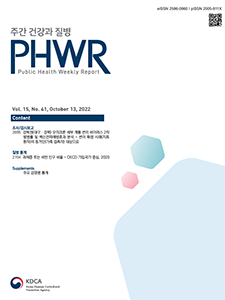Current Issue
Vol.15 No.41, October 13, 2022
-
Surveillance Reports 2022-10-13
 0
0
 4150
4150
 456
456
Secondary Attack Rate and Vaccine Effectiveness Against Omicron Sub-lineage Transmissions from Index Cases to Household Contacts in Gyeongbuk
Hanul Park, Chungmin Park, Myung-Jae Hwang, Seong-Ju Choi, Tae Jong Son*
Public Health Weekly Report 2022; 15(41): 2695-2703 https://doi.org/10.56786/PHWR.2022.15.41.2695AbstractOn November 30, 2021, the first case of omicron variants with fast transmission and immune avoidance characteristics against vaccines was confirmed in the Republic of Korea. The omicron variants have been recently classified and reported in detail as BA.1.1, BA.2, BA.3, BA.4, and BA.5. For approximately 2 months from April 24 to June 27, 2022, we confirmed the secondary attack rate and vaccine effectiveness against transmission (VET) in 82 confirmed cases of the omicron sub-lineage virus (BA.2.12.1, BA.4, and BA.5) and 156 household. In our study, the secondary attack rate by detailed lineage was the highest in the BA.4 variant (42.86%), followed by BA.2.12.12.1 (41.18%) and BA.5 (37.36%) variants. Regarding the BA.5 variant, the secondary attack rate was the highest among unvaccinated persons (45.45%), followed by those who had received three (35.94%) and two (33.33%) vaccine doses. When VET was confirmed, the two doses group had a VET of 30% and the three doses group had 37% compared with the unvaccinated group. But, it was not significant. The two doses group had a VET of 30% and the three doses group had 37% compared with the unvaccinated group. Our study is meaningful because it confirmed the secondary attack rate and vaccine effectiveness against Omicron sub-lineage transmissions from index cases to household contacts in Gyeongbuk.
-
QuickStats 2022-10-13
 1
1
 2427
2427
 651
651
Overweight or Obesity Rates in OECD Countries in 2020
Public Health Weekly Report 2022; 15(41): 2704-2705 https://doi.org/10.56786/PHWR.2022.15.41.2704

pp. 1433~1461
Most Keyword
?
What is Most Keyword?
- It is the most frequently used keyword in articles in this journal for the past two years.
Most Read
-
Waterborne and Foodborne Disease Outbreaks in the Republic of Korea, 2023
Myung-Jae Hwang, So Yeon Park, Hyungjun Kim, Se Jeong Yang, Sungchan Yang, Jin Seon Yang
Public Health Weekly Report 2025;18: 17-32 https://doi.org/10.56786/PHWR.2025.18.1.2 -
Implementation Plan for the Coronavirus Disease 2019 Vaccination for the 2024–2025 Season: Recommendations of the 6th Expert Committee on Immunization Practices
Hyewook Hwang, Wookeon Lee, Seohyeon Ahn, Young-Sook Choi, Seunghyun Lewis Kwon, Dongwoo Lee, Eun Hwa Choi, SokGoo Lee
Public Health Weekly Report 2025;18: 90-102 https://doi.org/10.56786/PHWR.2025.18.2.3
Editorial Office
+82-43-719-7569





 Full Text
Full Text Cite
Cite


